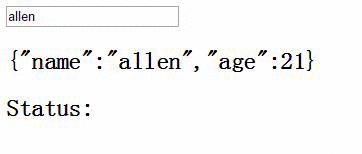Angular中使用 watch監聽object屬性值的變化
阿新 • • 發佈:2018-12-21
Angular中的$watch可以監聽屬性值的變化,然後並做出相應處理。
常見用法:
$scope.$watch("person", function(n, o){ //todo something...})- 1
- 2
- 3
但是對於一個物件中的某個屬性值變化時,$watch似乎不管用了。
示例程式碼:
<body> <div ng-controller="mainCtrl"> <input id="myText" type="text" ng-model="person.name"/> <h2>{{person}}</h2 - 1
- 2
- 3
- 4
- 5
- 6
- 7
- 8
- 9
- 10
- 11
- 12
- 13
- 14
- 15
- 16
- 17
- 18
- 19
- 20
- 21
- 22
- 23
- 24
我們為輸入框綁定了person物件的name屬性,然而當我們改變輸入框的值時候,{{person}}確實改變了,然而並沒有出現我們想要的change字元。
效果:
我們需要為$watch方法額外新增一個true引數,使之達到我們想要的效果:
$scope.$watch("person", function(n, o){ if(n == o){ return; } $scope.status = "changed";},true)- 1
- 2
- 3
- 4
- 5
- 6
$watch方法完整的使用方式是這樣的:
$watch(watchExpression, [listener], [objectEquality]);- 1
第一個是監聽的引數名稱,剩下兩個可選引數分別為處理函式和是相等比較的方式,對於後者文件如是說:Compare for object equality using angular.equals instead of comparing for reference equality. 即是否使用angular.equals方法進行比較。
如此效果變為:


